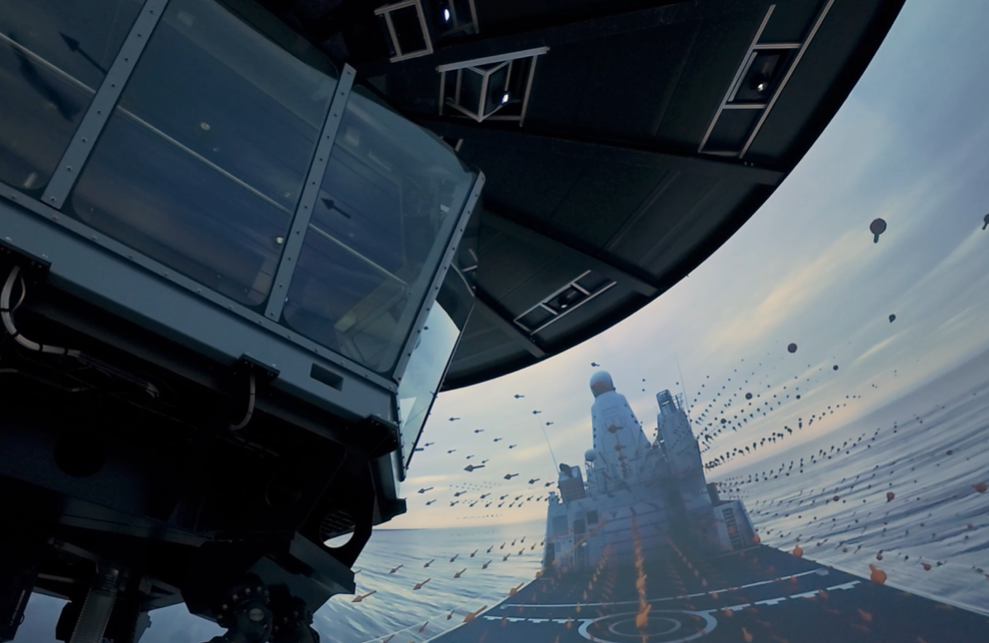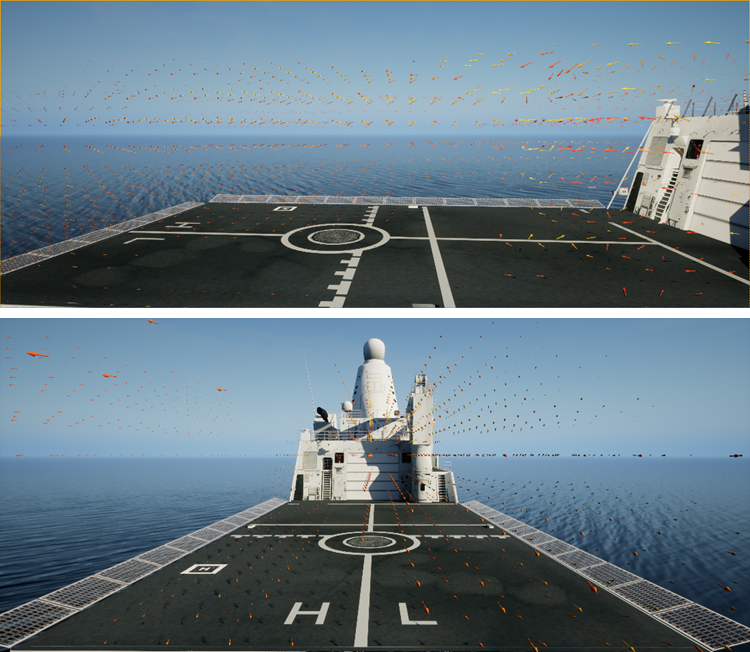December 2024, no. 142
Create a MARIN account to stay updated

Report
High-fidelity CFD
The consortium combined high-fidelity Computational Fluid Dynamics (CFD) software suites with medium-fidelity tools to accomplish the defined project objectives. This approach results in a better understanding of the drone’s air flow and loading in the vicinity of the ship’s superstructure. MARIN’s CFD solver ReFRESCO was successfully coupled with NLR’s CFD solver ENSOLV by means of the OpenPALM coupler. OpenPALM is software allowing the concurrent execution and the intercommunication of programs based on in-house, as well as commercial codes.
The disadvantage of this approach is the computational intensity. This method only works practically for a limited number of environmental conditions and is not a feasible option for real-time applications. Therefore, the developed method was extended with medium-fidelity tools to overcome this issue. The disturbed wind field near the ship’s superstructure is obtained from CFD computations and used as input for the medium fidelity approach. Here the hydrodynamic part of the simulation is configured in MARIN’s eXtensible Modelling Framework (XMF), while the UAV and its controller are configured in Flightlab by NLR. In Flightlab the ship motions and environmental conditions are obtained from imported data sets for now.
It is the consortium’s next ambition to integrate these two medium-fidelity tools into a single simulation. Hereafter, the developed UAV controller strategies by the NLDA will be tested and optimised in this common simulation setup. Finally, we aim to optimise the flight path depending on the wind conditions and anticipate the ship’s flightdeck motions. The intermediate milestone of this ambition was successfully demonstrated in the Large Motion Simulator. Besides the ship’s hydrodynamics, the presence of the ship’s superstructure air wake and flight trajectory to the landing pad were rendered by means of the Unreal Engine. The work will continue through the SPEEDOPS and TEMPESTAS collaboration projects over the next three years. Additionally, the German Navy will join as a project partner.
In 2020, the Naval Operation of Tactical Unmanned Systems (NOTUS) project started to collaborate on the topic of aerial drone operations near ships. The NOTUS project consortium consists of NLR, MARIN and the Netherlands Defence Academy (NLDA).
In October 2024, the project’s close-out meeting was held in MARIN’s new simulator centre (SOSc), in which project deliverables were presented and demonstrated in the Large Motion Simulator (LMS). The LMS is a six degrees of freedom, motion-based platform of 4.5 x 5.5 m on a hexapod with a payload of 14,000 kg. It features 360 degrees projection in a large spherical dome with a diameter of 16 m.
NOTUS - a Dutch collaboration in the field of naval ships and aerial drone operations
Unmanned aerial vehicles (UAV) have been a mainstay technology among the military and navies in particular. However, because drone developments follow each other in rapid succession, MARIN and the Royal Netherlands Aerospace Centre (NLR) have joined forces to develop an aero/hydrodynamic simulation environment on behalf of the Royal Netherlands Navy.


The main goal of this common numerical setup is to assess UAV launch or recovery operations in a maritime environment from and to a navy vessel. For specific combinations of drone and ship types and relevant sea/wind conditions, its workability should be addressed by onboard measurements and flight tests. However, it would be very costly, impractical and also inherently risky to test a drone with unproven capabilities in bad weather. A better option to accomplish this is through simulations, provided they include the relevant parameters and have sufficient accuracy. This numerical approach has everything required to make maritime operations safer. It provides the most realistic behaviour in a practical and efficient manner.
Unreal Engine rendering of a disturbed wind field at the helideck, derived from ReFRESCO CFD computations.

Bottom view of the LMS motion base and the Unreal Engine projection of the NOTUS demonstration scenario.
Interested? Contact us to discuss your options
MARIN’s CFD solver ReFRESCO was successfully coupled with NLR’s CFD solver ENSOLV.




MARIN’s CFD solver ReFRESCO was successfully coupled with NLR’s CFD solver ENSOLV.
High-fidelity CFD
The consortium combined high-fidelity Computational Fluid Dynamics (CFD) software suites with medium-fidelity tools to accomplish the defined project objectives. This approach results in a better understanding of the drone’s air flow and loading in the vicinity of the ship’s superstructure. MARIN’s CFD solver ReFRESCO was successfully coupled with NLR’s CFD solver ENSOLV by means of the OpenPALM coupler. OpenPALM is software allowing the concurrent execution and the intercommunication of programs based on in-house, as well as commercial codes.
The disadvantage of this approach is the computational intensity. This method only works practically for a limited number of environmental conditions and is not a feasible option for real-time applications. Therefore, the developed method was extended with medium-fidelity tools to overcome this issue. The disturbed wind field near the ship’s superstructure is obtained from CFD computations and used as input for the medium fidelity approach. Here the hydrodynamic part of the simulation is configured in MARIN’s eXtensible Modelling Framework (XMF), while the UAV and its controller are configured in Flightlab by NLR. In Flightlab the ship motions and environmental conditions are obtained from imported data sets for now.
It is the consortium’s next ambition to integrate these two medium-fidelity tools into a single simulation. Hereafter, the developed UAV controller strategies by the NLDA will be tested and optimised in this common simulation setup. Finally, we aim to optimise the flight path depending on the wind conditions and anticipate the ship’s flightdeck motions. The intermediate milestone of this ambition was successfully demonstrated in the Large Motion Simulator. Besides the ship’s hydrodynamics, the presence of the ship’s superstructure air wake and flight trajectory to the landing pad were rendered by means of the Unreal Engine. The work will continue through the SPEEDOPS and TEMPESTAS collaboration projects over the next three years. Additionally, the German Navy will join as a project partner.

Unreal Engine rendering of a disturbed wind field at the helideck, derived from ReFRESCO CFD computations.

Bottom view of the LMS motion base and the Unreal Engine projection of the NOTUS demonstration scenario.
December 2024, no. 142
Eelco Frickel
Senior Researcher/Team Leader
The main goal of this common numerical setup is to assess UAV launch or recovery operations in a maritime environment from and to a navy vessel. For specific combinations of drone and ship types and relevant sea/wind conditions, its workability should be addressed by onboard measurements and flight tests. However, it would be very costly, impractical and also inherently risky to test a drone with unproven capabilities in bad weather. A better option to accomplish this is through simulations, provided they include the relevant parameters and have sufficient accuracy. This numerical approach has everything required to make maritime operations safer. It provides the most realistic behaviour in a practical and efficient manner.
In 2020, the Naval Operation of Tactical Unmanned Systems (NOTUS) project started to collaborate on the topic of aerial drone operations near ships. The NOTUS project consortium consists of NLR, MARIN and the Netherlands Defence Academy (NLDA).
In October 2024, the project’s close-out meeting was held in MARIN’s new simulator centre (SOSc), in which project deliverables were presented and demonstrated in the Large Motion Simulator (LMS). The LMS is a six degrees of freedom, motion-based platform of 4.5 x 5.5 m on a hexapod with a payload of 14,000 kg. It features 360 degrees projection in a large spherical dome with a diameter of 16 m.
Unmanned aerial vehicles (UAV) have been a mainstay technology among the military and navies in particular. However, because drone developments follow each other in rapid succession, MARIN and the Royal Netherlands Aerospace Centre (NLR) have joined forces to develop an aero/hydrodynamic simulation environment on behalf of the Royal Netherlands Navy.
NOTUS - a Dutch collaboration in the field of naval ships and aerial drone operations
Interested? Contact us to discuss your options
Report
Create a MARIN account to stay updated













